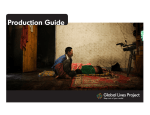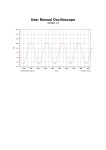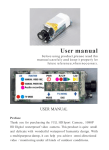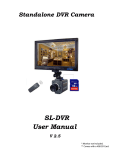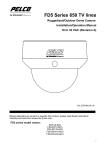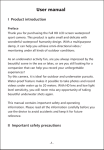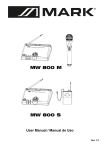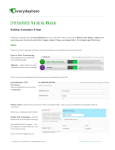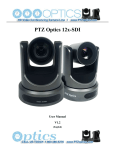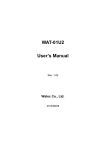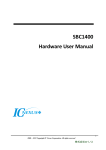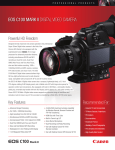Download Pre-production - Global Lives Project
Transcript
Pre-production At this stage, finalizing preparations for production go into effect. As the producer, you will confirm key elements, such as the on-screen participant, shoot date and locations, and all members of the crew. You will produce an extremely detailed schedule for the Life Story interview and the 24-hour video. You will confirm and document travel arrangements; create and distribute a call sheet; arrange for drivers, translators, food services. You will finalize budget and put financial arrangements in place through Global Lives Project and/or your own fundraising efforts. Additionally, during pre-production, you will arrange to have volunteers confirmed for post-production and translation. Post-production consists primarily of finalizing your Life Story interview and the 24-hour video, transcribing and translating all of the footage to English (and potentially other languages), and editing a 2-5 minute short from your shoots. By the end of pre-production, you and your crew should be fully prepared and equipped for your Life Story interview and 24-hour production. Post-production volunteers should be confirmed to ingest media immediately following the shoot. Table of Contents Assemble your production crew Key roles and responsibilities Create a fundraising plan Identify shoot date and location Contact local embassy for doc requirements Build and distribute shoot schedule Obtain written and/or oral release Plan your equipment Sample Documents Call sheet Budget spreadsheet Equipment list Shoot schedule Sample questions for Life Story interview Assemble your production crew Crews vary greatly in size. In our experience producing GLP video, we have found that the smaller the crew, the better the 24-hour experience. A smaller crew leads to less interference in the on-screen participant's life and makes for a more realistic day's experience. It also makes for less work in terms of training crew, organization, transport, etc., and helps to cut down on costs. We recommend that you have at least five people and no more than ten people on your 1 crew. Anything less increases stress and fatigue to the point of placing the production's quality and completion at risk. We highly recommend that the crew be made up of natives or people with extensive experience in the region; however we are aware that it may be difficult to find an entire crew in remote regions. It is best if the entire crew—local or not—be culturally sensitive and aware of local customs and norms, in order to best gain access/trust to the community and best capture the spirit of the region. If you are looking for volunteer crew, we recommend contacting film schools (nearby to where the shoot will take place); posting “want ads” to websites such as Idealist.org, Lightstalkers, Craigslist; and sending emails to your video production contacts to see if anyone is available or knows of others who may be interested in volunteering. Specify up front that volunteers must pay for their own transportation (flights, trains, etc.) to and from the shoot location. View the crew list from a previous GLP shoot. In addition to assembling the crew, we recommend that you build partnerships with local institutions—universities, NGOs, community leaders. These partnerships are extremely valuable for supporting filmmakers with post-production, translation, technology-access, and showcasing films. Key roles and responsibilities: Depending on the size of your video crew, one person may perform more than one role (i.e., the producer may also serve as the director, the production assistant may serve as the still photographer, etc.). These roles must be fulfilled in order to successful produce your GLP video. ● Producer: Plans and oversees all logistical, technical and budgetary aspects of the shoot. The producer identifies on-screen participant, hires crew, oversees budget, and establishes shoot schedule and locations. The producer coordinates equipment, media drives, batteries, vehicle(s) and transport of crew. The producer is ultimately responsible for delivering the Life Story interview and 24hour video to GLP, per the GLP specification. The Producer signs the production contract with GLP and receives the funds personally or through a fiscal agent or organizational sponsor. ● Director: Responsible for the look and feel of the video. The director guides the technical crew (primarily camera operators), and when necessary, directs the on-screen participant. Often the producer will serve as director. Note: While crew members can work in shifts, the director of a GLP shoot must be present during the entire 24-hour production. ● Two camera operators: In addition to having one experienced camera operator shooting at all times, you must have a backup camera operator (BCO) on 2 location at all times. The BCO should be proficient in operating the specific video camera and on-hand for when the experienced operator needs a break. ● Audio engineer: Responsible for the type and placement of microphones, the setting of levels, and ultimately capturing “clean” audio. ● Production assistant: Mainly responsible for offloading and duplicating media onto hard drives and ensuring camera batteries and mic batteries are always charged and available. ● Still photographer: Responsible for capturing high-quality stills throughout the day to document both the on-screen participant as well as the production team at work. ● Community liaison/fixer: Responsible for liaising between production crew and residents of the community, including on-screen participant. Should know the area and be fluent in the native language of the community as well as a language spoken by all of the crew members. Depending on your shoot location, you may also need to recruit a driver, interpreter, or security person. In a best-case scenario, your community liaison would serve in one (or all) of these roles. Once your crew is confirmed, schedule a conference call (Skype, etc.) and/or send an introductory email to the crew, listing names, roles and responsibilities, and contact info for each person. Encourage direct communication among crew, prior to the shoot. Circulate a draft call sheet and PDF manuals of key equipment to be used, especially the video camera. Create a fundraising plan Funding support from GLP is dependent on availability of our funds and the quality of your proposal. Although crew members are expected to volunteer their time, producers are expected to fundraise (and/or find additional resources through volunteers) to offset expenses such as travel, lodging and rental of equipment. It is possible to borrow and secure in-kind donations for nearly all aspects of a GLP shoot, but usually some cash is necessary. If you would like to use a crowd-funding platform like Kickstarter, the GLP staff will help to promote your campaign through Facebook, Twitter and our newsletter, once your proposal is gets the green-light. Because the Life Story Interview and 24-hour video are translated into multiple languages for global accessibility, fundraising also needs to include any expected costs associated with translation and transcription coordination expenses. This could include food and venue for volunteer translator workdays, or funds to pay translators. The funds that GLP provides cannot be used to make direct payments to individual volunteers, including translators. 3 View the budget from a previous GLP shoot. Identify shoot date and locations Budget time for getting to know your On-Screen Participant, prior to shooting the Life Story Interview and the 24-hour video. We recommend that you organize a social event (dinner, etc.) in which you, the crew, and the On-Screen Participant attend and get to know each other. This will make for a better, more intimate, and comfortable environment when shooting. Life Story interview: You will conduct the Life Story interview 1-3 days prior to shooting your 24-hour video. Allocate four hours (on-camera) to interview the on-screen participant. Shoot the interview in a quiet environment, with little to no audio distraction (see Guidelines for Recording the Life Story interview). 24-hour video: As much as possible, ascertain where and what the on-screen participant will be doing during every hour of the day. Then, based on your on-screen participant’s schedule, plan your production schedule, factor in transportation to and from shoot locations, division of labor, release forms, and your plans for navigating everchanging lighting conditions. Plan to shoot for 26 hours: Throughout the day, expect to lose minutes here and there (for things like battery and memory card swaps). And of course, you may run into a snafu or two and lose more than a few minutes. As such, we strongly advise that you record 26 hours to ensure you capture 24 hours of useable, uninterrupted footage. Maximize resources: Crew members can be "recycled" from shift to shift. For example, for a rural shoot, four six-hour shifts may be appropriate, using each team twice. Be creative and make sure that you always have an awake and alert person behind the cameras (video and still) and someone close by to help out with whatever they need. If necessary, photographers can help out video camera operators; directors can take still photography shifts, etc. View the schedule from a previous GLP shoot. Contact your local embassy for doc requirements Depending on whether you and your crew will be entering another country, you may want to contact the local embassy to find out what visas are available and what paperwork is required to enter the country. For example, the GLP Lebanon crew had to obtain media passes to shoot in Lebanon. In contrast, the GLP Kazakhstan crew entered the country on tourist visas. Tip: When entering a country, don't offer additional details beyond what is explicitly requested. 4 Obtain written and/or oral release Everyone who appears on camera for more than a few seconds and whose face appears on camera in a way that they can be singularly identified must consent to being filmed, either by written or oral consent, with the exception of crowds or people shot in public places. If subject is illiterate, use an oral release. For public places, please make a large "Recording in Progress" sign and mount it in such a way that it can stand up on its own and be transported easily. In the case of an oral release, you must have a third video camera, since oral release footage must be separate from the 24-hour video and Life Story interview. The oral release script is as follows: "I, _____ (name), consent to be in the Global Lives Project video, and my image and voice can be shown anywhere for any purpose." Do not include oral release within the 24 hour video or Life Story video, but submit them separately as per guidelines in post-production document. All crew members must sign a written release form. Oral releases are unacceptable for this purpose, given that the form includes confirmation that their participation in GLP is as a volunteer and that they will not be paid. Plan your equipment Below you’ll find guidance on what to consider when choosing equipment. As part of preproduction, you will need to create an equipment list. View the equipment list from a previous 24-hour GLP shoot. Cameras: You must use an HD camera that records directly to an SD memory card or hard drive (we no longer accept footage on tape). You should have at least two HD video cameras during the day of the shoot – preferably the same model. In addition to the video cameras, bring a DSLR camera for shooting still photos of the production in progress. Still photos are absolutely essential. We use them in print materials and on our website. Do not use a DSLR camera as your main video camera, due to problems with camera shake and limited recording times. Confirm that all camera operators are familiar with your chosen HD camera, its presets, button layout, etc., prior to shooting. Download and print user manuals and have them on hand during the shoot. If camera operators do not have experience with the camera, schedule a training session that allows for handling the camera and viewing test footage on a monitor. Note: HD cameras are notoriously difficult for operators specifically in the areas of focusing and low-light performance. It is important to give operators time to set program presets for the different parts of the shoot. Pay close attention to the effects of slowshutter, gain and iris controls. Audio setup: We recommend a 2-channel mic setup with a directional mic (shotgun) mounted on the camera and a wireless lav mic attached to the on-screen participant at all times. If you are using an HD camera that only has a stereo-mini audio input, you can acquire an adapter that will allow you to have two XLR inputs. Test your recording setup several times prior to recording. 5 Microphones break, so bring backup solutions: Wireless mics—even the most expensive ones—break regularly. Bring both a backup set of wireless mics and an extra-long XLR cable and the appropriate mount in case you need to turn your shotgun mic into a boom. If you're traveling to a remote location for the shoot, you probably won't want to bring a boom pole, but you should identify a broom handle or something else on location that can be made into a boom if necessary. Equipment checklist Video ● Main video camera (preferably 1080p 24fps) ● Second video camera (best if identical to main camera, for use either in rotation or as backup) ● Third video camera (optional - can be a small camcorder or phone camera - for behind the scenes/oral release footage) ● Tripod (for sleeping hours and Life Story interview) ● Extra batteries and external chargers for all cameras. Estimate that batteries may last only 30% of what they are rated, especially in hot climates ● Laptop and external media drive – two media hard drives: one for offloading footage and photos from memory cards, the other for duplicating the media (in case a hard drive fails, which is a regular occurrence). It’s best to use a buspowered hard drive if you’ll be operating in locations where you can’t plug in the hard drive to electricity. ● Extra laptop batteries ● Memory cards – The number of memory cards will depend on various factors, including the type of camera you are using on the shoot. For example, the Sony EX3/EX1 shoots HD video at 35mbps so you get about 112 min on 32GB cards. A Canon C300 shoots HD video at 50mbps so you get about 82min on 32GB cards. Consumer HD cameras shoot highly compressed HD and, as a result can fit more footage on the cards. Refer to the camera manufacturer’s website or the user manual. ● Wireless Mics x2 (main and backup) ● Shotgun Mics x2 (main and backup) ● Extra batteries for mics ● Power extension cords and surge protectors/splitters so that you can charge batteries as much as possible. Photography ● Digital SLR ● Batteries for DSLR ● Extra memory cards ● Laptop and hard disk to offload photos Miscellaneous ● GPS Logger, USB cable and batteries 6 ● Gaffer tape ● Safety pins ● Food and drink for the crew - sandwiches, energy bars, cookies, caffeinated beverages, etc. Get food that won't make a mess and can be eaten and cleared away quickly. ● Camera assistant pouch (blower, cleaner, chamois etc.) ● Reflector/bounce card (in the event you shoot Life Story interview outside) Optional ● Steadicam ● Production van (nice to have as a base for the shoot and a place to take a nap) ● Portable light (don't bring anything too big or intimidating) ● Generator (for locations without reliable electricity) 7







